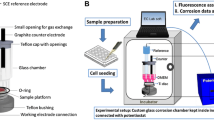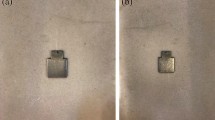Abstract
Ions released from metallic dental materials used in orthodontic appliances could induce undesirable effects on cells and tissues. This study evaluates the biocompatibility of two of the most labile components of metallic dental alloys on osteoblastlike cells. The influence of protein and ions on metal dissolution properties is also investigated using different electrolyte solutions. Morphological alterations, cell growth, and differentiation of osteoblasts were assessed after exposure to pure metals (Ag, Cu, Pd, Au) and Ni−Ti alloy and correlated with the kinetics of elements released into the culture media. Results showed that Cu and Ag were the most cytotoxic elements and the other metals were biocompatible with the osteoblasts. The parameters of biocompatibility were correlated with the levels of ions detected into the culture media. Metal ions induced cell death through early mitosis arrest, apoptotic phenomena, and necrotic processes. Voltammograms showed that anions and proteins interfered in the corrosion process. Fetal bovine serum (FBS) strongly affected the electrochemical process, decreasing the oxidation rate of the metals. In conclusion, copper and silver ions showed a time-dependent low biocompatibility, which correlated with the concentration of released ions. The dissolution of the metallic materials was dependent on the composition of the simulated biological media.
Similar content being viewed by others
References
J. C. Wataha, Biocompatibility of dental casting alloys: a review, J. Prosthet. Dent. 83, 223–234 (2000).
R. G. Craig, Restorative Dental Materials, Mosby-YearBook, St Louis, MO, pp. 146–153 and 387–389 (1997).
G. Schmalz, H. Langer, and H. Schweikl, Cytotoxicity of dental alloy extracts and corresponding metal salts solutions, J. Dent. Res. 77 1772–1778 (1998).
J. C. Wataha, C. T. Malcolm, and C. T. Hanks Correlation between cytotoxicity and the elements released by dental casting alloys, Int. J. Prosthodont. 8, 9–14 (1995).
N. C. Partridge, D. Alcorn, V. P. Michelangeli, et al., Morphological and biochemical characterization of four clonal osteogenic sarcoma cell lines of rat origin, Cancer Res. 43, 4308–4312 (1983).
L. D. Quarles, D. A. Yahay, L. W. Lever, et al., Distinct proliferative and differentiated stages of murine MC3T3E1 cells in culture an in vitro model of osteoblast development, J. Bone Miner. Res. 7, 683–692 (1992).
A. Kapanen, J. Ilvesaro, A. Danilov, et al., Behaviour of nitinol in osteoblast-like ROS-17 cell cultures, Biomaterials 23, 645–650 (2002).
R. L. W. Messer, S. Bishop, and L. C. Lucas, Effects of metallic ion toxicity on human gingival fibroblasts morphology, Biomaterials 20, 1647–1657 (1999).
V. Grill, M. A. Sandrucci, R. Di Lenarda, et al., Biocompatibility evaluation of dental metal alloys in vitro: Expression of extracellular matrix molecules and its relationship to cell proliferation rates, J. Biomed. Mater. Res. 52, 479–487 (2000).
P. Locci, L. Marinucci, C. Lilli, et al., Biocompatibility of alloys used in orthodontics evaluated by cell culture tests. J. Biomed. Mater. Res. 51, 561–568 (2000).
J. C. Wataha, C. T. Hanks, and R. G. Craig, The in vitro effects of metal cations on eukaryotic cell metabolism, J. Biomed. Mater. Res. 25, 1133–1149 (1991).
M. C. Cortizo, M. A. Fernández Lorenzo de Mele, and A. M. Cortizo, In vitro evaluation of biocompatibility of dental metal materials on osteoblast cells in culture, in Metal Ions in Biology and Medicine L. Khassanova, Ph. Collery, I. Maymard, Z. Khassanova, and J-C. Étienne, eds., John Libbey Eurotext, Paris Vol. 7, pp. 149–153 (2002).
A. Schedle, P. Samorapoompichit, W. Fureder, et al., Metal ion-induced toxic histamine release from human basophils and mast cells, J. Biomed. Mater. Res. 39, 560–567 (1998).
M. Kaga, N. S. Seale, T. Hanawa, et al., Cytotoxicity of amalgams alloys and their elements and phases, Dent. Mater. 7, 68–72 (1991).
D. F. Williams, I. N. Askill, and R. Smith, Protein adsorption and desorption phenomena on clean metal surfaces, J. Biomed. Mater. Res., 19, 313–320 (1985).
R. L. Williams and D. F. Williams, Albuminum adsorption on metal surfaces, Biomaterials 9, 206–212 (1988).
J. C. Wataha, S. K. Nelson, and P. E. Lockwood, Elemental release from dental casting alloys into biological media with and without proteins Dent. Mater. 17, 409–414 (2001).
K. Merrit, S. A. Brown, and N. A. Sharkey, The binding of metal stals and corrosion products to cells and proteins in vitro, J. Biomed. Mater. Res. 18, 1005–1015 (1984).
M. A. Khan, R. L. Williams, and D. F. Williams, The corrosion behaviour of Ti−6Al-4V, Ti−6Al−7Nb and Ti−13Nb−13Zr in protein solutions, Biomaterials 20, 631–637 (1999).
K. Endo, Chemical modification of metallic implant surfaces with biofunctional proteins (Part 2). Corrosion resistance of a chemically midified NiTi alloy, Dent. Mater. J. 14, 199–210(1995).
F. J. Gil, L. A. Sánchez, A. Espias, et al., In vitro corrosion behaviour and metallic ion release of different prosthodontic alloys, Int. Dent. J. 49, 361–367 (1999).
M. A. Fernández L de Mele and G. Duffó, Tarnishing and corrosion of silver-based casting alloys in synthetic salivas of different compositions, J. Appl. Electrochem. 32, 157–164 (2002).
M. A. Fernández L de Mele and M. C. Cortizo, Electrochemical behaviour of titanium in fluoride-containing saliva, J. Appl. Electrochem. 30, 95–100 (2000).
H. J. Mueller, The binding of corroded metallic ions to salivary-type proteins, Biomaterials 4, 66–72 (1983).
International Standards Organization, Biological evaluation of medical devices. Part 5: Tests for cytotoxicity: in vitro methods ISO 10993-5-(1997).
A. M. Cortizo and S. B. Etcheverry, Vanadium derivatives act as growth factor-mimetic compounds upon differentiation and proliferation of osteoblast-like UMR106 cells, Mol. Cell. Biochem. 145, 97–102 (1995).
A. D. McCarthy, S. B. Etcheverry, L. Bruzzone, et al., Effects of advanced glycation end-products on the proliferation and differentiation of osteoblast-like cells, Mol. Cell. Biochem. 170, 43–51 (1997).
M. S. Cortizo, J. L. Allesandini, S. B. Etcheverry, et al., A vanadium/aspirin complex controlled release using a poly(β-propiolactone) film. Effects on osteosarcoma cells. J. Biomater. Sci. Polym. 12, 945–960 (2001).
G. S. Stein and J. B. Lian, Molecular mechanism mediating proliferation/differentiation interrelationships during progressive development of the osteoblast phenotype, Endocr. Rev. 14, 424–442 (1993).
M. Bradford, Rapid and sensitive method for quantitation of microgram quantities of protein utilizing the principle of protein-dye binding, Anal. Biochem. 72, 248–254 (1976).
M. C. Cortizo and M. A. Fernández L de Mele, Preliminary characterization of thin biofilms by optical microscopy, Biofouling 15, 253–260 (2000).
M. A. Fernández Lorenzo de Mele, R. C. Salvarezza, V. D. Vázquez Moll, et al., Kinetics and mechanism of silver chloride electroformation during the localized electrodissolutions of silver in solutions containing chloride, J. Electrochem. Soc. 133, 746–752 (1986).
A. M. Cortizo, L. Bruzzone, S. Molinuevo, et al., A possible role of oxidative stress in the vanadium-induced cytotoxicity in the MC3T3E1 osteoblast and UMR106 osteosarcoma cell lines, Toxicology 147, 89–99 (2000).
A. M. Cortizo, M. Caporossi, G. Lettieri, et al., Vanadate-induced nitric oxide production: role in osteoblast growth and differentiation, Eur. J. Pharmacol. 400, 279–285 (2000).
L. D. Tomei and F. O. Cope (eds.), Current Communications in Cellular and Molecular Biology, Cold Spring Harbor Laboratory Press, Cold Spring Harbor, NY, Vol. 3 (1991).
D. Granchi, E. Cenni, G. Ciapetti, et al., Cell death induced by metal ions: necrosis or opoptosis? J. Mater. Sci.: Mater. Med. 9, 31–37 (1998).
P. Nicotera, M. Leist, and E. Ferrando-May, Apoptosis and necrosis: different execution of the same death, Biochem. Soc. Symp. 66, 69–73 (1999).
S. Van Cruchten and W. Van den Broeck, Morphological and biochemical aspects of apoptosis, oncosis and necrosis, Anat. Histol. Embryol. 31, 214–223 (2002).
P. S. Stewart, A review of experimental measurements of effective diffuse permeabilities and effective diffusion coefficients in biofilms, Biotechnol. Bioeng. 59, 261–272 (1998).
Y. Mao, W. Wei, H. Peng, et al., Monitoring for adsorption of human serum albumin and bovine serum albumin onto bare and polystyrene-modified silver electrodes by quartz crystal impedance analysis, J. Biotechnol. 89, 1–10 (2001).
A. Klinger, D. Steinberg, D. Kohavi, et al., Mechanism of adsorption of human albumin titanium in vitro. J. Biomed. Mater. Res. 36, 387–392 (1997).
Author information
Authors and Affiliations
Rights and permissions
About this article
Cite this article
Cortizo, M.C., de Mele, M.F.L. & Cortizo, A.M. Metallic dental material biocompatibility in osteoblastlike cells. Biol Trace Elem Res 100, 151–168 (2004). https://doi.org/10.1385/BTER:100:2:151
Received:
Accepted:
Issue Date:
DOI: https://doi.org/10.1385/BTER:100:2:151




